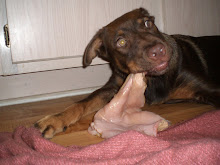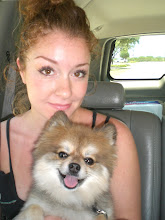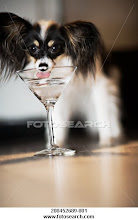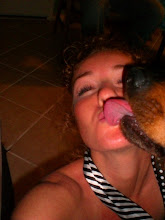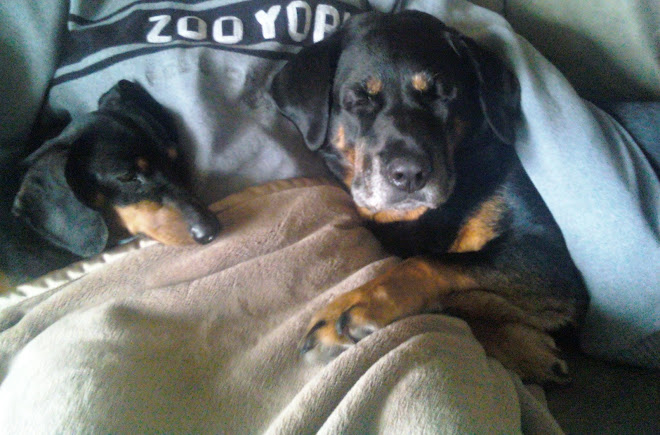I have heard it said-"Picky eaters are not born, they are created"...and I find that statement to be 100% true.
When I started feeding Teddy, my dachshund, raw he took to it right away. He ate everything without even a question. Then, one day he looked up at me like "What the heck did you just put in my bowl? I am NOT eating that!" He took one quick sniff and walked away. This was the same food he had been devouring for months. He had a variety of different meats and this was one of the mixes. I was perplexed. Was he sick? Did he not like it anymore? Did I add too much of one thing or another? None of those questions were even close to the real issue. The answer was much simpler than that.
He just wasn't hungry.
How did I figure this out? Well, after recalculating his daily intake and realizing I was off and feeding him too much I cut back his food. There must have been a time period within this food intake switch when he was really hungry, because he never again even thought twice when I put food out for him. Being a little hungry once for Teddy was enough to never put his nose up at food again. Now, he will eat absolutely anything raw I put in front of him. He will NOT eat kibble, grain, a chip dropped on the ground, anything that isn't raw, meat, or bone. He is a true carnivore and he is definitely not picky for anything raw or meaty.
Something to be noted is that some dogs fast themselves and don't want to eat everyday. If they have normal energy levels and are drinking water normally then there is nothing to be alarmed about. It is actually very natural and very healthy for a dog to self-regulate like that.
Now what if the issue is that your dog is hungry, but just won't eat what you put out for him? This is what you must do and you must be very disciplined, or else you will have a dog running you around in circles tripping over his tail!
This is the scenario: You put out your dog's food. Your dog sniffs it, maybe licks it and walks away. Leave the food out for 15 minutes. Some dogs like their food room temperature. If still untouched then put the food away until next mealtime. Between this time DO NOT feed your dog any "yummy treats", kibble, table scraps, etc. Be strong and know that you need to decide what your dog eats or you will both be living a very stressful life if he is choosing the menu.
Next mealtime put the food out again. If he does the same thing you can try to add Parmesan cheese, garlic powder, something to entice him just to realize that it is real, yummy, healthy food in front of him. Then walk away. Do not encourage him to eat. Do not praise him if he eats. And especially DO NOT throw any other nervous, concerned energy out there. Just know in your mind that your dog will not starve himself. If he is still not eating after 15 minutes, pick up the food and put it up until next mealtime. Now, if you have kibble in the house, dog treats, raw hide, anything that he knows you can feed him if he refuses for long enough, please get rid of it. Dogs are smart and if he has gotten you to give in before then he knows you most likely will again.
Keep strong and when you put the food out next mealtime you may not even have a chance to blink before it is gone. After that your dog will eat whatever you offer.
Remember you are not starving your dog; they are simply refusing to eat food that you offer. Eventually they will come around and they will definitely thank you for it!
Saturday, May 30, 2009
Thursday, May 28, 2009
Step-by-step on how to feed the S.A.D. Dog Sushi Raw Dog Food Diet
If you are reading this then you either have already begun to use S.A.D. Dog Sushi's service or you are just curious about how it all works. This short article should be helpful to both parties.
After you give us your dog's weight and receive your first shipment of food, you may not be sure exactly how to feed the food, in what order, and if you have to weigh anything out. Here is a step-by-step article addressing just that.
We package the food in large Ziploc bags, within those bags are smaller packs, measured out for each dog. The large Ziploc bags have numbers at the top. The first day of feeding will have a #1. The contents of the #1 bag will have a 2-3 day supply of food, individually wrapped and weighed out with your dog's first letter of their name marked on it. The #1 large Ziploc bag will tell you what is in the 1-2 week batch of food. The first week of food will just be chicken backs/necks. We introduce 1 protein at a time to make sure there are no allergies, to keep the dog from having diarrhea, and to make it easy for the feeder.
Since the first week of food is just backs/necks or both, one package inside the Ziploc will represent 1 day of food. If you like to feed 2 x/day then just take out half in the a.m. and feed the rest in the p.m. If you have a puppy, we will separate it into 2-3 packages for you, since puppies need to eat more times per day.
The second week we will introduce another protein and the patties. So the raw meaty bones will still be chicken and the patties will either be turkey, pork, or beef. They will also have 10% organ meat (bone ground in is another option). The patties will either be in their own large Ziploc bags, with 3-4 days of patties in each bag or in with the RMBs. Either way, it will all be labeled and easy to follow. Your dog will get one patty pack and one RMB pack per day, so one patty pack and one RMB pack equals one full day of food. These will already be weighed out for each dog and labeled so you know who gets what. All you have to do is take it out of the package and feed.
As the diet progresses, we slowly introduce more variety, so we can monitor your dog along the way. We can find out what works best for you and your animal, since everyone, even furry-ones are unique, and have their own special needs and preferences.
After you give us your dog's weight and receive your first shipment of food, you may not be sure exactly how to feed the food, in what order, and if you have to weigh anything out. Here is a step-by-step article addressing just that.
We package the food in large Ziploc bags, within those bags are smaller packs, measured out for each dog. The large Ziploc bags have numbers at the top. The first day of feeding will have a #1. The contents of the #1 bag will have a 2-3 day supply of food, individually wrapped and weighed out with your dog's first letter of their name marked on it. The #1 large Ziploc bag will tell you what is in the 1-2 week batch of food. The first week of food will just be chicken backs/necks. We introduce 1 protein at a time to make sure there are no allergies, to keep the dog from having diarrhea, and to make it easy for the feeder.
Since the first week of food is just backs/necks or both, one package inside the Ziploc will represent 1 day of food. If you like to feed 2 x/day then just take out half in the a.m. and feed the rest in the p.m. If you have a puppy, we will separate it into 2-3 packages for you, since puppies need to eat more times per day.
The second week we will introduce another protein and the patties. So the raw meaty bones will still be chicken and the patties will either be turkey, pork, or beef. They will also have 10% organ meat (bone ground in is another option). The patties will either be in their own large Ziploc bags, with 3-4 days of patties in each bag or in with the RMBs. Either way, it will all be labeled and easy to follow. Your dog will get one patty pack and one RMB pack per day, so one patty pack and one RMB pack equals one full day of food. These will already be weighed out for each dog and labeled so you know who gets what. All you have to do is take it out of the package and feed.
As the diet progresses, we slowly introduce more variety, so we can monitor your dog along the way. We can find out what works best for you and your animal, since everyone, even furry-ones are unique, and have their own special needs and preferences.
Wednesday, May 27, 2009
How to introduce a puppy to raw
There is nothing better than starting a puppy off on the right foot; that includes feeding the best and healthiest diet possible. A puppy fed raw will know how to crunch and tear apart those bones right off the bat. Their jaw strength isn't quite the capacity of adults, but they have sharp teeth and instinct going for them.
At first, you may need to hold the bone or meat out for them so they can really get into it. Soon enough they will be using their own paws to hold the bone as they pull off the meaty meat. My puppy is such an excellent raw eater. When I watch her it reminds me of watching wolves or lions on National Geographic tear apart their prey. She even makes the same facial expression as she crunches down on that meat and bone.
Chicken bones will be the easiest for the dogs to eat at first, since they are so pliable, flexible, and soft. My 13 week old puppy (German Shepherd/Rottweiler/Red Doberman) can also eat lamb breast bones with no problems at all. Also, make sure to keep bones out for teething, such as beef necks, ribs, or other beef bones. My puppy does not even think to chew on the furniture or my shoes when she has those bones to help her with teething.
So how many times do you feed per day and how much? Since puppies have small bellies and fast metabolisms, they need to eat more, smaller meals per day. 3-5 meals per day may suffice. A good place to start is to feed them 2-3% of their expected, ADULT body weight broken up into small meals. But, puppies are also excellent self-regulators. If you let them eat when they are hungry and stop when they are full they will carry on this self-regulatory trait into adulthood. It is another benefit of raw feeding. Kibble has the opposite effect. It prohibits puppies and dogs from knowing when they are full, so some dogs eat kibble like gold fish eat flakes...fast and mindlessly. To us it is like eating french fries or sugary treats.
Finally, make sure to introduce variety early on. You will have a puppy who will not be a picky eater as an adult. Even if your pup turns down food one time, reintroduce it again. One try is never enough for a puppy. Also, the variety will create a well-balanced diet for your furry baby.
At first, you may need to hold the bone or meat out for them so they can really get into it. Soon enough they will be using their own paws to hold the bone as they pull off the meaty meat. My puppy is such an excellent raw eater. When I watch her it reminds me of watching wolves or lions on National Geographic tear apart their prey. She even makes the same facial expression as she crunches down on that meat and bone.
Chicken bones will be the easiest for the dogs to eat at first, since they are so pliable, flexible, and soft. My 13 week old puppy (German Shepherd/Rottweiler/Red Doberman) can also eat lamb breast bones with no problems at all. Also, make sure to keep bones out for teething, such as beef necks, ribs, or other beef bones. My puppy does not even think to chew on the furniture or my shoes when she has those bones to help her with teething.
So how many times do you feed per day and how much? Since puppies have small bellies and fast metabolisms, they need to eat more, smaller meals per day. 3-5 meals per day may suffice. A good place to start is to feed them 2-3% of their expected, ADULT body weight broken up into small meals. But, puppies are also excellent self-regulators. If you let them eat when they are hungry and stop when they are full they will carry on this self-regulatory trait into adulthood. It is another benefit of raw feeding. Kibble has the opposite effect. It prohibits puppies and dogs from knowing when they are full, so some dogs eat kibble like gold fish eat flakes...fast and mindlessly. To us it is like eating french fries or sugary treats.
Finally, make sure to introduce variety early on. You will have a puppy who will not be a picky eater as an adult. Even if your pup turns down food one time, reintroduce it again. One try is never enough for a puppy. Also, the variety will create a well-balanced diet for your furry baby.
Cheap chicken from WalMart-it is not a GOOD deal
The frozen, enhanced chicken from Walmart or other retailers is not a "good" deal. Many people want to save a buck and see chicken for .54 cents/lb. Sounds great to feed your dog, right? The problem is many, many dogs are allergic to enhanced meats. Enhanced means there are additives, such as broth, sodium, etc. added to the chicken. It causes itching in dogs, loose stools, etc. So people new to raw may think that their dog is allergic to chicken, when actually the dog is only allergic to enhanced chicken. If you do it yourself, read the labels, and please feed all NATURAL. It may not say "enhanced", but the sodium content, if much higher than 80 mg, will give it away.
Subscribe to:
Posts (Atom)




